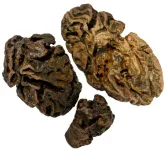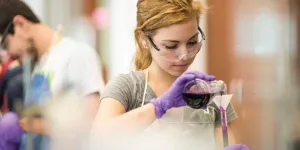(Press-News.org) People who are ‘double jointed,’ a condition formally known as generalised joint hypermobility, may be at heightened risk of long COVID, suggests a case-control study published in the open access journal BMJ Public Health.
They were 30% more likely not to have fully recovered from COVID-19 infection than those without hypermobile joints, and to be experiencing the persistent fatigue associated with long COVID, the findings indicate.
Other than older age, the likelihood of developing long COVID seems to be greater when associated with certain underlying health conditions, including fibromyalgia, irritable bowel syndrome, migraine, allergies, anxiety, depression and back pain, explain the researchers.
These risk factors have all been independently associated with joint hypermobility, whereby some or all of a person's joints have an unusually large range of movement.
The researchers therefore wanted to find out if double jointedness might be a risk factor for long COVID in its own right, and drew on 3064 participants in the COVID Symptom Study Biobank, all of whom had had COVID-19 infection at least once.
These participants were surveyed in August 2022 to find out if they had hypermobile joints, if they had fully recovered from their last bout of COVID-19 infection, and if they were experiencing persistent fatigue.
Most (81.5%) said they had had COVID-19 at least once. Of these, information on self-reported recovery was available for 2854, of whom 2331 (82%) were women and 2767 (97.5%) were White. Their average age was 57 (range 21–89).
Around 1 in 3 (914; 32%) said they had not fully recovered from their last bout of COVID-19 infection, and of these, 269 (just under 30%) had generalised joint hypermobility.
Among the 1940 people who said they had fully recovered, almost 1 in 4 (439; just under 23%) had hypermobile joints; 400 of them were women.
After accounting for potentially influential factors, including age, sex, ethnicity, deprivation level, educational attainment, and number of vaccinations received, joint hypermobility was strongly associated with a failure to recover fully from COVID-19 infection.
People who were double jointed were around 30% more likely to say they hadn’t fully recovered from COVID-19 infection than those with normal joints. And joint hypermobility significantly predicted high levels of fatigue, which emerged as an instrumental factor in the failure to make a full recovery.
This is an observational study, and as such, no firm conclusions can be drawn about whether joint hypermobility is a causal factor for long COVID. The researchers also acknowledge various limitations to their findings—including that most of the study participants were women and of White ethnicity.
Nor did their analysis include or correct for other potentially influential factors, such as duration of symptoms and coronavirus variant, or pre-existing conditions, such as fibromyalgia, which is itself characterised by fatigue and brain fog.
As has been suggested before, long COVID is unlikely to be a single entity, but a medley of intersecting immunological, inflammatory, autonomic nervous system, respiratory and cardiovascular processes that lead to distinct symptom profiles affecting body and brain, say the researchers.
And there are probably several causes, and therefore no one treatment strategy, for long COVID, they point out, adding: “However, these results suggest further exploration of whether [joint hypermobility] is linked to a particular phenotype or subtype of those not recovering fully from COVID-19, including long COVID.”
END
People who are ‘double jointed’ may be at heightened risk of long COVID
People with condition 30% more likely not to fully recover from COVID-19 infection
2024-03-20
ELSE PRESS RELEASES FROM THIS DATE:
Air quality around planned new schools in England “alarmingly poor”
2024-03-20
The air quality around planned new schools in England is “alarmingly poor,” with 86% of sites exceeding World Health Organization (WHO) targets on major air pollutants, reveals an analysis published online in the Archives of Disease in Childhood.
The consequences for health from exposure to excessive levels of air pollutants are well known, say the researchers, who call for air quality assessment at all stages of planning to be mandated, and legislation and guidance to be updated as a matter of urgency.
Children are particularly vulnerable to the harmful effects of air pollution, because their bodies, organs, and immune systems are still developing, explain ...
Study reveals ‘cozy domesticity’ of prehistoric stilt-house dwellers in England’s ancient marshland
2024-03-20
A major report on the remains of a stilt village that was engulfed in flames almost 3,000 years ago reveals in unprecedented detail the daily lives of England’s prehistoric fenlanders.
Must Farm, a late Bronze Age settlement, dates to around 850BC, with University of Cambridge archaeologists unearthing four large wooden roundhouses and a square entranceway structure – all of which had been constructed on stilts above a slow-moving river.
The entire hamlet stood approximately two metres above the riverbed, with walkways bridging some of the main houses, and ...
New archive of ancient human brains challenges misconceptions of soft tissue preservation
2024-03-20
Soft tissue preservation in the geological record is relatively rare, and, except where deliberate intervention halts the process of decay (like embalming or freezing), the survival of entire organs is particularly unusual. The spontaneous preservation of the brain in the absence of any other soft tissues - that is, the brain’s survival amongst otherwise skeletonised remains - has historically been regarded as a ‘one-of-a kind’ phenomenon.
A new study conducted by researchers at the University of Oxford, led ...
Swallowable sensors could pinpoint gut movement problems for patients
2024-03-20
Scientists have developed an ingestible capsule dotted with sensors that can detect pressure in a patient’s guts and detect points of failure.
The ingestible system will give colorectal medical teams an unprecedented understanding of the movement of a patient’s digestive tract, or lack thereof.
Instead of simply taking images of inside the guts, the system will sense whether it’s contracting, how much pressure is exerted and exactly where it might be inactive.
The system has been tested in a synthetic gut and animals. A patent for the technology is pending.
The team from Heriot-Watt University and the University of Birmingham, with colleagues from the University ...
Genetic test identifies patients with triple negative breast cancer who are unlikely to respond to immunotherapies
2024-03-20
Milan, Italy: Researchers have developed a genetic test that can identify how patients with triple negative early-stage breast cancer will respond to immunotherapy drugs. This means that patients who are unlikely to respond to these drugs can avoid the adverse side effects associated with them and can be treated with other therapies.
Professor Laura van ‘t Veer told the 14th European Breast Cancer Conference that the latest results from the I-SPY2 trial [1] suggest that the current standard of care for patients with triple negative breast cancer should be reconsidered.
“Immunotherapy drugs can ...
Similar DNA changes found in cells of both smokers and e-cigarette users
2024-03-20
E-cigarette users with a limited smoking history experience similar DNA changes to specific cheek cells as smokers, finds a new study led by researchers at UCL (University College London) and University of Innsbruck.
This study is an incremental step in helping researchers to build a deeper understanding of the long-term effects of e-cigarettes on health. Although it does not show that e-cigarettes cause cancer, studies with long-term follow up are important to assess whether e-cigarettes have harmful effects and, if so, what they are.
The study, published in Cancer Research, ...
New data show pembrolizumab improves breast cancer outcomes regardless of age or menopausal status
2024-03-20
Milan, Italy: New data from the KEYNOTE-756 phase 3 clinical trial show that adding the immunotherapy drug, pembrolizumab, to chemotherapy before and after surgery for breast cancer leads to better outcomes for patients regardless of their age or menopausal status.
The findings, presented at the 14th European Breast Cancer Conference (EBCC 14) today (Wednesday), add to information available on the effect of pembrolizumab in patients with early-stage breast cancer that is at high risk of recurring or spreading further, and that is oestrogen ...
UTA federal research projects add $38 million to economy
2024-03-19
The economic impact of federally sponsored research at The University of Texas at Arlington was $38 million in 2022, with expenditures spread among 725 unique vendors, according to a new report. Of that total, the University spent about $24 million on research-related goods and services in Texas.
The research dollars also supported the salaries of 1,562 people during this time—including 517 faculty and 746 students.
“Research at UTA helps solve some of society’s most important problems, and it is also a vital economic driver in our economy and in the careers of our students and researchers,” said Kate Miller, vice president of research and ...
Rice researchers develop 3D-printed wood from its own natural components
2024-03-19
Researchers at Rice University have unlocked the potential to use 3D printing to make sustainable wood structures, offering a greener alternative to traditional manufacturing methods.
Wood has historically been marred by wasteful practices generated during shaping processes, driving up costs and environmental impact. Now researchers in materials science and nanoengineering at Rice have developed an additive-free, water-based ink made of lignin and cellulose, the fundamental building blocks of wood. The ink can be used to produce architecturally ...
Machine learning used to classify fossils of extinct pollen
2024-03-19
In the quest to decipher the evolutionary relationships of extinct organisms from fossils, researchers often face challenges in discerning key features from weathered fossils, or with prioritizing characteristics of organisms for the most accurate placement within a phylogenetic tree. Enter neural networks, sophisticated algorithms that underlie today’s image recognition technology.
While previous attempts to utilize neural networks in classifying extinct organisms within phylogenetic trees have struggled, a new study, recently published in PNAS Nexus, heralds a significant breakthrough. The model has been trained ...
LAST 30 PRESS RELEASES:
University of Oklahoma researcher awarded funding to pursue AI-powered material design
Exploring how the visual system recovers following injury
Support for parents with infants at pediatric check-ups leads to better reading and math skills in elementary school
Kids’ behavioral health is a growing share of family health costs
Day & night: Cancer disrupts the brain’s natural rhythm
COVID-19 vaccination significantly reduces risk to pregnant women and baby
The role of vaccination in maternal and perinatal outcomes associated with COVID-19 in pregnancy
Mayo Clinic smartwatch system helps parents shorten and defuse children's severe tantrums early
Behavioral health spending spikes to 40% of all children’s health expenditures, nearly doubling in a decade
Digital cognitive behavioral treatment for generalized anxiety disorder
Expenditures for pediatric behavioral health care over time and estimated family financial burden
Air conditioning in nursing homes and mortality during extreme heat
The Alps to lose a record number of glaciers in the next decade
What makes a good proton conductor?
New science reporting guide published for journalists in Bulgaria
New international study reveals major survival gaps among children with cancer
New science reporting guide published for journalists in Turkey
Scientists develop a smarter mRNA therapy that knows which cells to target
Neuroanatomy-informed brain–machine hybrid intelligence for robust acoustic target detection
Eight SwRI hydrogen projects funded by ENERGYWERX
The Lundquist Institute and its start-up company Vitalex Biosciences Announces Strategic Advancement of Second-Generation fungal Vaccine VXV-01 through Phase 1 Trials under $40 Million Competitive Con
Fine particles in pollution are associated with early signs of autoimmune disease
Review article | Towards a Global Ground-Based Earth Observatory (GGBEO): Leveraging existing systems and networks
Penn and UMich create world’s smallest programmable, autonomous robots
Cleveland researchers launch first major study to address ‘hidden performance killer’ in athletes
To connect across politics, try saying what you oppose
Modulating key interaction prevents virus from entering cells
Project explores barriers to NHS career progression facing international medical graduates
Jeonbuk National University researchers explore the impact of different seasonings on the flavor perception of Doenjang soup
Two Keck Medicine of USC Hospitals named Leapfrog Top Teaching Hospitals
[Press-News.org] People who are ‘double jointed’ may be at heightened risk of long COVIDPeople with condition 30% more likely not to fully recover from COVID-19 infection







